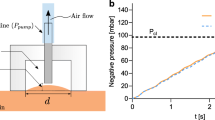Abstract
The electrochemical properties of human cadaver skin were studied in a diffusion cell with impedance spectroscopy as a function of time in the absence and presence of penetration enhancers dodecyl N,N-dimethylamino acetate and Azone. An improved electrochemical model of skin is presented, and combining the novel model with modern fractal mathematics, the effect of enhancers on the surface of skin is demonstrated. The enhancers appeared to open new penetration routes and increase the ohmic resistance, capacitive properties, and fractal dimension of skin, which means a rougher or more heterogeneous surface.
Similar content being viewed by others
REFERENCES
V. Srinivasan, W. I. Higuchi, S. M. Sims, A. H. Ghanem, and C. R. Behl. Transdermal iontophoretic drug delivery: Mechanistic analysis and application to polypeptide delivery. J. Pharm. Sci. 78:370–375 (1989).
T. Yamamoto and Y. Yamamoto. Electrical properties of the epidermal stratum corneum. Med. Biol. Eng. 14:151–158 (176).
T. Yamamoto and Y. Yamamoto. Analysis for the change of skin impedance. Med. Biol. Eng. Comput. 15:219–227 (1977).
T. Yamamoto and Y. Yamamoto. Dispersion and correlation of the parameters for skin impedance. Med. Biol. Eng. Comput. 16:592–594 (1978).
Y. Yamamoto, T. Yamamoto, S. Ohta, T. Uehara, S. Tahara, and Y. Ishizuka. The measurement principle for evaluating the performance of drugs and cosmetics by skin impedance. Med. Biol. Eng. Comput. 16:623–632 (1978).
S. Grimnes. Skin impedance and electro-osmosis in the human epidermis. Med. Biol. Eng. Comput. 21:739–749 (1983).
A. Boxtel. Skin resistance during square-wave electrical pulses of 1 to 10 mA. Med. Biol. Eng. Comput. 15:679–687 (1977).
J. Rosell, J. Colominas, P. Riu, R. Pallas-Areny, and J. G. Webster. Skin impedance from 1 Hz to 1 MHz. IEEE Trans. Biomed. Eng. 35:649–651 (1988).
J. D. DeNuzzio and B. Berner. Electrochemical and iontophoretic studies of human skin. J. Contr. Release 11:105–112 (1990).
R. R. Burnette and B. Ongpipattanakul. Characterization of the permselective properties of excised human skin during iontophoresis. J. Pharm. Sci. 76:765–773 (1987).
R. R. Burnette and B. Ongpipattanakul. Characterization of the pore transport properties and tissue alteration of excised human skin during iontophoresis. J. Pharm. Sci. 77:132–137 (1988).
M. J. Pikal. Transport mechanisms in iontophoresis. I. A theoretical model for the effect of electroosmotic flow on flux enhancement in transdermal iontophoresis. Pharm. Res. 7:118–126 (1990).
M. J. Pikal and S. Shah. Transport mechanisms in iontophoresis. II. Electroosmotic flow and transference number measurements for hairless mouse skin. Pharm. Res. 7:213–221 (1990).
M. J. Pikal and S. Shah. Transport mechanisms in iontophoresis. III. An experimental study of the contributions of electroosmotic flow and permeability change in transport of low and high molecular weight solutes. Pharm. Res. 7:222–229 (1990).
S. M. Sims. Iontophoretic Transport Mechanisms Across Skin, Dissertation thesis, University of Utah, Salt Lake City, 1991.
S. M. Sims, W. I. Higuchi, and V. Srinivasan. Skin alteration and convective solvent flow effects during iontophoresis. I. Neutral solute transport across human skin. Int. J. Pharm. 69:109–121 (1991).
A. K. Banga and Y. W. Chien. Iontophoretic delivery of drugs: Fundamentals, developments and biomedical applications. J. Contr. Release 7:1–24 (1988).
J. Hirvonen, J. H. Rytting, P. Paronen, and A. Urtti. Dodecyl N,N-dimethylamino acetate and Azone enhance drug penetration across human, snake, and rabbit skin. Pharm. Res. 8:933–937 (1991).
B. A. Boukamp. A nonlinear least square fit procedure for analysis of immittance data of electrochemical systems. Solid State Ion. 20:31–44 (1986).
K. S. Cole. Membranes, Ions and Impulses, University of California Press, Berkeley, 1968.
J. R. MacDonald (ed.). Impedance Spectroscopy, John Wiley, New York, 1987.
T. Pajkossy. Electrochemistry at fractal surfaces. J. Electroanal. Chem. 300:1–11 (1991).
R. F. Voss. In H. O. Peitgen and D. Saupe (eds.), The Science of Fractal Images, Springer-Verlag, New York, 1988, Chap. 4.
P. M. Elias. Epidermal barrier function: Intercellular lamellar lipid structures, origin, composition and metabolism. J. Contr. Release 15:199–208 (1991).
J. Hirvonen, R. Rajala, E. Laine, P. Paronen, and A. Urtti. Penetration enhancers dodecyl N,N-dimethylamino acetate and Azone alter the structure of the skin—A DSC study. In R. C. Scott, H. E. Bodde, R. H. Guy, and J. Hadgraft (eds.), Proceedings of the 2nd Conference of Prediction of Percutaneous Penetration, Southampton 2:350–354 (1991).
B. Dubuc, S. W. Zucker, C. Tricot, J. F. Quiniou, and D. Wehbi. Evaluating the fractal dimension of surfaces. Proc. R. Soc. London A425:113–127 (1989).
C. Moler, J. Little, and S. Bangert. PC-MATLAB for MS-DOS Personal Computers, The MathWorks Inc., 1987.
J. Hirvonen, K. Kontturi, L. Murtomäki, P. Paronen, and A. Urtti. Transdermal iontophoresis of sotalol and salicylate; the effect of skin charge and penetration enhancers. J. Contr. Release (submitted).
J.-P. Diard, B. Le Gorrec, and C. Montella. Calculation, simulation and interpretation of electrochemical impedances. J. Electroanal. Chem. 326:13–36 (1992).
Author information
Authors and Affiliations
Rights and permissions
About this article
Cite this article
Kontturi, K., Murtomäki, L., Hirvonen, J. et al. Electrochemical Characterization of Human Skin by Impedance Spectroscopy: The Effect of Penetration Enhancers. Pharm Res 10, 381–385 (1993). https://doi.org/10.1023/A:1018984121415
Issue Date:
DOI: https://doi.org/10.1023/A:1018984121415




